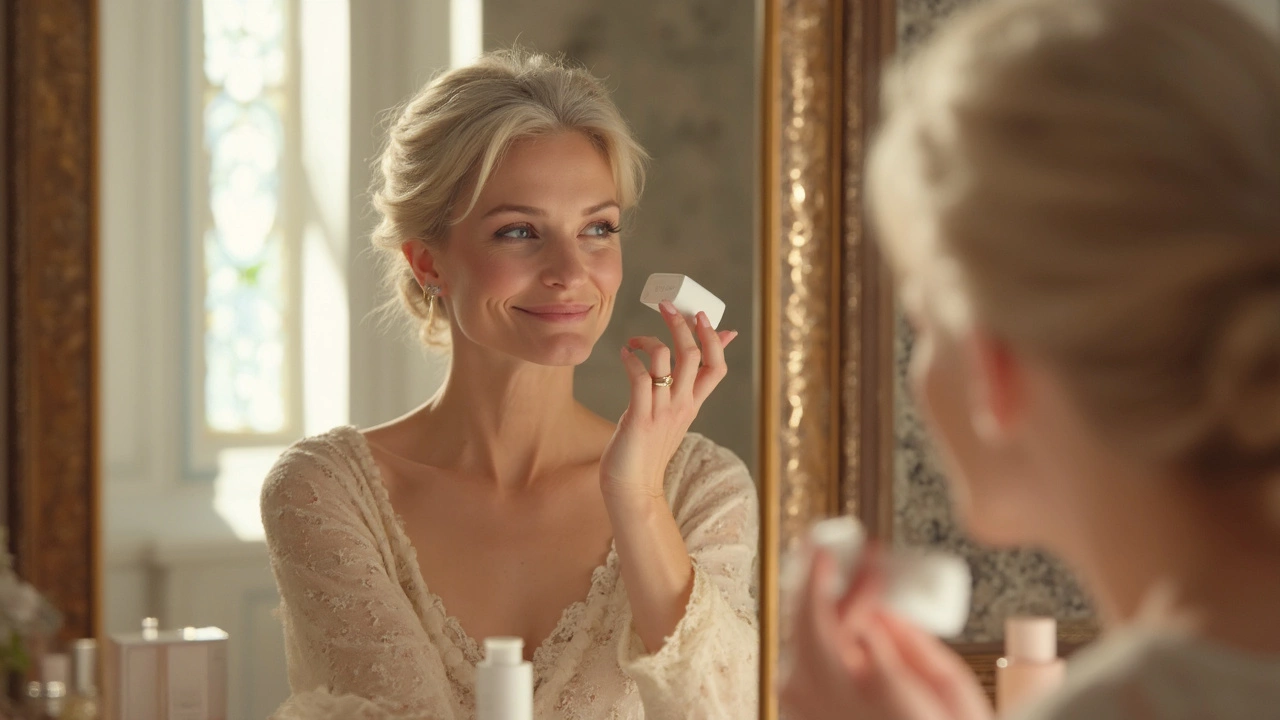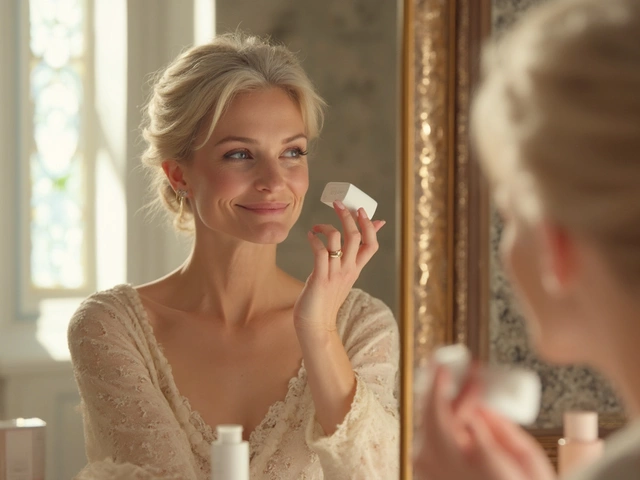The first signs of aging creep up before you know it—lines around the eyes, dull skin, maybe a bit of sagging. Guess what? You don’t need to just sit back and watch it happen. Small choices can make a big difference, even if you’re not ready for needles or lasers yet.
One of the best ways to repair aging skin is with sunscreen. Sounds too easy, but over 80% of visible aging comes from sun damage and skipping SPF undoes every fancy cream you use. Daily sunscreen stops new wrinkles and spots from popping up in the first place. Looking to fade existing lines? Retinol creams can help. Dermatologists swear by them because they boost collagen, which means firmer, smoother skin over time.
There’s also good news if you’re not ready to change your routine completely. Just swapping harsh cleansers for gentle, hydrating ones keeps skin from getting dry and tight, which makes lines stand out more. Drinking enough water and eating colorful veggies isn’t just health advice—it actually helps your skin look brighter and plumper.
- How Skin Ages: What Happens Over Time
- Everyday Habits That Help Repair Your Face
- In-Office Procedures That Make a Difference
- At-Home Tricks and Products That Really Work
How Skin Ages: What Happens Over Time
Your face changes with age, and it’s not just about wrinkles showing up. The deeper layers of your skin lose collagen and elastin—those are the proteins that keep everything tight and bouncy. Less collagen means skin gets thinner, so it bruises and wrinkles more easily. Collagen drops by about 1% each year after your twenties, and that stacks up fast.
Another big thing: skin doesn’t hold onto moisture like it did. Oil glands slow down, which is why your face can feel dry or crepey as you get older. Add in years of sun, pollution, and maybe a few late nights, and you’re looking at spots, uneven tone, and loss of glow.
The fat pads in your face also shrink and move around. You know that full, fresh look kids have? That goes away, and you start to see hollow cheeks, deeper lines around your mouth, and sagging along the jawline. It’s just gravity and time—not your fault! Here’s a quick rundown of what’s really going on:
- Aging face = less collagen and elastin, so the structure weakens over time.
- Decrease in natural oils and moisture—skin looks dull or feels rough.
- Fat shifts, making cheeks flatter and jawlines softer.
- Repeated expression lines settle in as permanent wrinkles.
- Years of sun exposure lead to brown spots and rough patches.
The table below shows what typically changes with each decade:
| Age | Main Changes |
|---|---|
| 20s | Collagen starts to decline; prevention matters |
| 30s | Fine lines appear, especially around eyes |
| 40s | Loss of firmness, more lines, dry skin |
| 50s+ | Thinning skin, deep wrinkles, spots, sagging |
Understanding all this is key. You can target the main causes and really make a difference with the right habits and treatments.
Everyday Habits That Help Repair Your Face
You don’t need a fancy clinic to start fixing damage and getting a younger-looking face. Most improvements start with what you do every single day—and these changes cost little or nothing. The trick is being consistent, because skin repairs itself slow and steady.
One biggie is sleep. Studies show that people who get 7-8 hours a night have less noticeable wrinkles and better skin barrier function. So if you are regularly skimping, your face will show it. Use a clean pillowcase (switching it twice a week is smart) to keep bacteria and oil from clogging up your pores while you sleep.
Hydration is another move that’s backed by science. Drink water all day instead of loading up at night. Dry skin exaggerates wrinkles. Eating foods high in antioxidants helps too. Think berries, spinach, and nuts. They fight off free radicals, which are one of the main reasons for skin aging.
| Habit | Proven Benefit | Time to See Results |
|---|---|---|
| Daily sunscreen (SPF 30+) | Prevents 80% of visible aging | 4-12 weeks |
| Retinol use at night | Reduces wrinkles, boosts collagen | 8-16 weeks |
| 7-8 hours sleep | Improved skin repair, fewer wrinkles | 2-6 weeks |
| Hydration (2L water/day) | Plumper, more elastic skin | 2-4 weeks |
| Antioxidant-rich diet | Brighter, less dull skin | 4-8 weeks |
The way you wash your face matters, too. Skip the super hot water and harsh scrubs. They strip moisture, making your skin more fragile. Gentle cleansers and lukewarm water protect your natural oils. Finish with a moisturizer. Even oily skin benefits from that extra layer to keep hydration in.
UV rays don’t care if it’s cloudy or you’re indoors near a window. Getting into the habit of applying a broad-spectrum SPF 30+ every morning is the number one anti-aging move according to dermatologists. It’s hands down the simplest way to fix and prevent damage at any age. If you do nothing else for your aging face, do this.
If you want to nudge things along, toss in a quick facial massage when you moisturize. It boosts blood flow, so skin glows just a bit brighter. These habits won’t make you look twenty-five again, but stick with them and your skin will absolutely be stronger, smoother, and healthier over time.

In-Office Procedures That Make a Difference
If creams just aren’t cutting it for you anymore, there are in-office treatments that bring more dramatic results. The best part? You don’t always need surgery for a major change. Dermatologists and skin clinics offer a bunch of options, and choosing the right one depends on your main goals—like smoothing out wrinkles, tightening skin, or just getting back some glow.
The most popular anti-aging treatment worldwide is Botox. It relaxes the muscles that cause frown lines and crow’s feet. Results usually show up in a few days and last 3–4 months, so you’ll want repeat treatments to keep it up. For deeper lines, dermal fillers—like Juvederm or Restylane—can plump up cheeks, lips, and even hands. They work fast and can last anywhere from six months to two years.
If your skin looks dull, microneedling can help. It uses tiny needles to create microscopic injuries, which makes your skin build more collagen and heal itself. Some clinics combine this with radiofrequency to tighten sagging skin on the jawline or neck. Another big one is laser resurfacing—these lasers zap away sun damage, brown spots, and lines. You’ll need some downtime, but the difference can be huge.
For a quick comparison of some top in-office procedures and what they target, check this table:
| Treatment | Main Benefit | Results Last | Average Downtime |
|---|---|---|---|
| Botox | Smooths expression lines | 3–4 months | None |
| Dermal Fillers | Restores lost volume | 6 months–2 years | None–a few days |
| Microneedling | Boosts collagen, improves texture | Several months | 1–3 days |
| Laser Resurfacing | Reduces spots and wrinkles | 1–2 years with good care | Up to 2 weeks |
| Radiofrequency | Tightens skin | Up to 1 year | None–2 days |
No single treatment fixes everything, but layering a few (like starting with Botox, then adding laser later) gives the best shot at real, lasting results. Remember: always choose a qualified professional. Cheap deals and shady salons can lead to burns, infections, or results you really don’t want. For a real fix to an aging face, you want the safest hands possible.
At-Home Tricks and Products That Really Work
If you’re not ready to jump into clinic treatments, you can still treat an aging face right at home—and it doesn’t take a drawer full of expensive bottles. The trick is picking what actually gets results, not just what’s trending on TikTok or smells good.
The king of anti-aging products? Retinol. This ingredient (which is a vitamin A derivative) encourages your skin to make more collagen. That means skin feels firmer and looks smoother, especially with regular use. Start slow if you’re new, maybe two nights a week, to dodge dryness. And always follow up with moisturizer.
Want a quick boost? Vitamin C serums are your friend. Vitamin C helps brighten dull skin and evens out those dark spots that seem to pop up overnight. It works best in the morning, right before sunscreen. Don’t forget the neck and chest—they age fast too.
Another underrated trick: swap your rough washcloth for a microfiber cloth. It gently removes makeup and dead skin without scratching, which reduces irritation and redness. Pair that with a hyaluronic acid serum for plumpness. Hyaluronic acid draws water into your skin, making fine lines look less noticeable—super helpful if your skin feels dry.
- Retinol at night for smoother, firmer skin
- Vitamin C in the morning for brightness
- Hyaluronic acid any time for plumping
- Gentle cleansers, not harsh scrubs
- Regular sunscreen
And about those fancy at-home face devices (think LED masks and microcurrent gadgets): They’re not magic, but some actually have solid data. For example, microcurrent devices can help stimulate facial muscles, making you look extra fresh after a session. The catch? You need to use them regularly, not just once before a big date.
Check out this quick comparison table of top ingredients and devices:
| Product/Trick | Main Benefit | How Often |
|---|---|---|
| Retinol | Reduces lines, firms skin | 2-3x/week, nighttime |
| Vitamin C | Brightens, fades spots | Daily, morning |
| Hyaluronic Acid | Hydrates, plumps | Daily, any time |
| Microfiber Cloth | Gentle exfoliation | Every cleanse |
| Microcurrent Device | Firms facial muscles | 3-5x/week |
Fixing an aging face at home boils down to consistency. Choose a few proven products, use them every day, and your skin will start to bounce back—no magic spells needed.

